Making this is simple. I first made a mixture of mirin and soy sauce (about 1 to 1, or reduce soy sauce for milder, sweeter variety. For one package of enoki, I used 2 tsp each. If you do not like it sweet, use sake or a sake and mirin mixture). I cut off the bottom 1/3 of the enoki mushroom and combined the mushrooms with the above seasoning in a small pan and let it simmer. I also added about 1/2 of the umeboshi cut up in small pieces. I also added a half sheet of dried nori torn up in small pieces (by hand). The dish can become salty very quickly depending on the how salty your umeboshi is and how much soy sauce you use. I cooked it for 5 minutes or so on simmer or until most of the liquid is gone. I served this as a small dish that goes with sake but you can use it as a rice condiment as well. This came out a bit on the salty side but it is perfect for sipping cold sake--encouraging you to drink more sake than you intended
Thursday, January 13, 2011
"Nametake" cooked and seasoned enoki mushroom ナメタケ
Tuesday, January 11, 2011
Stuffed Omelet オムレツ
This may not look like something you see in an Izakaya, but any good hearty breakfast item, in our opinion, can be had as a "shime" 締め or a mid-night snack after drinking--for those who are young and reckless. Stuffed omelets are very popular in Japan including ones stuffed with rice seasoned with ketchup called "Omuraisu" オムライス.

We are not big omelet eaters anymore but, in our reckless days, we often looked for nice brunch/omelet places over the weekend. While we were living in Los(t) Angles, our friend introduced us to one such place near the famous La Brea tar pit. We cannot remember the name of the place and I am sure it does not exist any longer. After that, I emulated how they made omelets at home. Omelets were cooked to order in front of the customers. There were many kinds of fillings to choose from, which were kept in a warming drawer.
Filling: I use whatever is available at the moment. This time, for one two-egg omelet, I use red onion (thinly sliced, 1/3 medium), fresh shiitake mushroom (stem removed and sliced, 4-5 medium), leftover oven roasted pork fillet (4-5 thin slices cut into strips), baby spinach (a very small handful) and fresh goat cheese (3 tbs). I first saute the onion in the mixture of olive oil and butter, add the pork and shiitake mushroom. After they are cooked, I add spinach and saute until wilted. Season with salt and pepper. Since nice "fond" is formed, I deglaze it with a Marsala wine (1 tbs, optional) and cook it until liquid is all gone. I add crumbled goat cheese (I do not mix at this point) and leave the mixture on the stove on a very low flame (our stove has a very low simmer setting or use as a "warm" setting if you are using an electric stove top) (#1, image below).
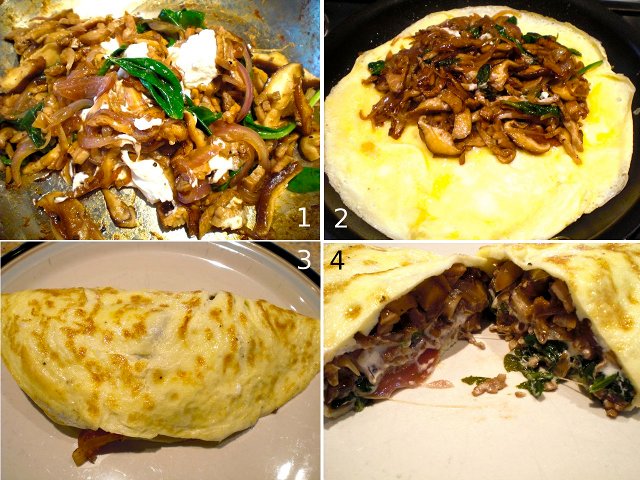
This is very satisfying dish. Since I am not making a living doing this, it is kind of fun to make omelets every-now-and-then. I had to admit that we had this as a breakfast not as a mid-night snack and we share one omelet.
Filling: I use whatever is available at the moment. This time, for one two-egg omelet, I use red onion (thinly sliced, 1/3 medium), fresh shiitake mushroom (stem removed and sliced, 4-5 medium), leftover oven roasted pork fillet (4-5 thin slices cut into strips), baby spinach (a very small handful) and fresh goat cheese (3 tbs). I first saute the onion in the mixture of olive oil and butter, add the pork and shiitake mushroom. After they are cooked, I add spinach and saute until wilted. Season with salt and pepper. Since nice "fond" is formed, I deglaze it with a Marsala wine (1 tbs, optional) and cook it until liquid is all gone. I add crumbled goat cheese (I do not mix at this point) and leave the mixture on the stove on a very low flame (our stove has a very low simmer setting or use as a "warm" setting if you are using an electric stove top) (#1, image below).
Eggs: I used two brown eggs (for one omelet) beaten with the addition of cream (2 tbs) and seasoned with salt and pepper. If you use 3 eggs, it will be easier to form an omelet but you can do it with two eggs.
In a non-stick frying pan with low side or an omelet pan (8 inch) on a medium low flame, I melt butter (1 tbs) and pour in the egg mixture. When the bottom is set, I use a small spatula to lift one side of the omelet and let the excess uncooked egg flow under the cooked portion. I repeat this on all four quadrants until the desired amount of liquid egg remains (I like it almost all cooked). If you want to make pristine yellow, not-browned omelets, you have to cook the eggs on a very low heat with a lid on to cook the omelet through (for a stuffed kind not for a plain French style) but I like some brown markings on my omelets. I add the filling, which was kept warm allowing the cheese to melt, onto half of the omelet--the half opposite the handle of the pan (#2 in the image below). Take a plate in the left hand and hold the frying pan in the right hand grabbing the handle from underneath (I am right-handed), angle the pan and slide it out and then fold over the omelet using the edge of the frying pan to cover the stuffing (I should have recruited my wife to take pictures). The omelet is done (#3 in the image below). I am not sure what this shot (#4) is called in food bloggers parlance (I have to defer to Jon), here is the cut section.
Sunday, January 9, 2011
Grilled fatty salmon belly 鮭のハラスの祐庵焼き
If I was cooking outside with a charcoal fire, I would simply grill it with some salt, which is the most simple and wonderful way to eat this. This time, I marinated the salmon belly in Yuuan-ji 祐庵地 (sake:mirin:soy sauce=1:1:2) for about one hour. I skewered and broiled it in a toaster oven for 3-4 minutes each side. I could have made the skin a bit crisper but this is such a nice dish to start with a drink of cold sake. For sure, it is better for you than eating "pork" belly, which is another wonderful belly you can savor. I served this with my usual cucumber with moromi miso もろみ味噌 and Campari tomato with mayonnaise.
Friday, January 7, 2011
Pork scallopini with Pennsylvania dutch egg noodle 豚肉スカルピーニとペンシルバニアダッチエッグヌードル
Wednesday, January 5, 2011
Chicken rice 鶏飯
This was a "shime" 締め we had one weekday evening. This is loosely based on the recipe from "Otsumami yokocho" volume 1, page 132. This dish "keihan" 鶏飯 is supposedly famous in Kagoshima prefecture 鹿児島 but a similar combination of boiled chicken and rice appears to be somewhat universal across the Asian ethnic food cultures with the Hainanese variation best known (we never had this but only saw it in the Anthony Bourdain's No reservations, Singapore episode).

The most important part of this dish is the broth/soup. This is not a recipe to follow but this was what happened. I was vaguely thinking about this dish when I ended up with excess kelp and bonito broth but it took almost 10 days before I finished the broth for this dish. I started this with the leftover Japanese dashi broth (using a dashi pack when I made "snap peas in broth"). I kept the dashi I did not use in the refrigerator for several days. When I deboned chicken thighs for another dish, I warmed up the dashi and added the chicken thigh bones (4) with more sake, slices of ginger and several stalks of scallion and simmered it for 30-40 minutes. I let it cool and again placed it in the refrigerator. The next day, I removed all the bones and congealed fat and strained it to a sealable container and kept it the fridge until today. I first warmed up the broth and gently poached a half skinless, boneless breast for 10 minutes. I took out the chicken breast and set aside. I added more sake, and light-colored "usukuchi" soy sauce 薄口醤油 to taste with a touch of mirin to finish the broth for this dish. This turned out to be a very nice delicate broth with a hint of ginger.
Digression alert: The two kanji letters (ideogram) "鶏飯" in "kun-yomi" 訓読み, or the pronunciation of the letter based on the meaning of the each letter in Japanese, will be "Tori-meshi" but if you pronounced it as such, it indicates a totally different type of a flavored rice dish with chicken meat mixed in. When you pronounce it using the sound related to the original ancient Chinese pronunciation of the letter or "on-yomi" 音読み, then it will be "Kei-han" indicating this dish. Nobody will care but, I am sure, Jon does.
I shredded the poached chicken into thin strands by hand after it was cool enough to handle. I also made "Golden thread omelet" or "kinshiran" 金糸卵 seasoned only with salt, julienne of cucumber and thinly sliced scallion. I just arranged these toppings on warm cooked rice in a bowl (I used frozen and microwaved rice) and poured the warm broth over top. I did not have miso-cured cucumber キュウリの味噌漬け or "Kaiware" daikon sprouts 貝割れ大根, which were called for in the recipe, and I forgot to add sesame seeds.
My wife usually does not like a dish with lots of liquid like "Ochazuke" お茶漬け as a "shime" dish but she really liked this dish especially the broth. She totally emptied the bowl including the broth. Next time, I will try to make the broth in much less than 10 days.
Monday, January 3, 2011
New year's day sashimi, marinaded salmon and salmon skin roll 元旦の刺身, ロシア漬けと手巻きサーモンスキンロール
This is a repeat of last year but we were again lucky enough to receive the shipment of sashimi from Catalina offshore products on December 31. This time we got fresh farm raised "Toro", which had "akami" 赤身, chutoro 中トロ and Ootoro 大トロ on it. In addition, we got anikimo, uni, and salmon roe. Ootoro was quite good. In the picture, the left back is "namasu" なます大根 topped with salmon roe. This year, I added yuzu juice in addition to rice vinegar which added a nice flavor. The golden uni was also excellent as usual (right back).
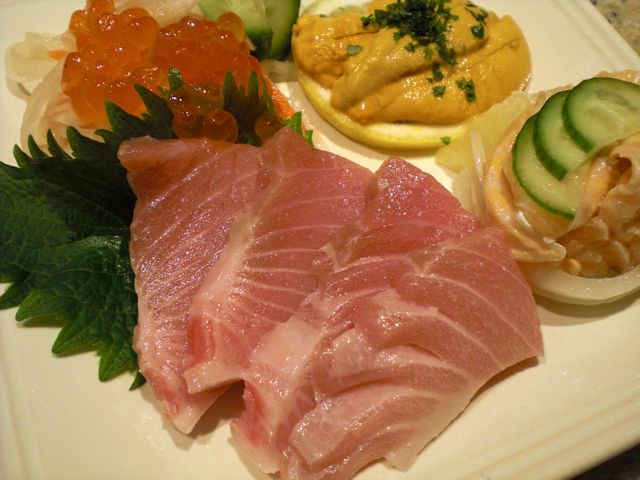
I also served marinated salmon which is my mother's recipe (right front). This salmon dish is called "Russian marinated salmon" ロシア漬け and my mother does not know how the dish got the name or where she got the recipe*. Of course, I made my contribution (read modification) to the recipe since I think the pith of the lemon imparts a bitter taste to the dish. Essentially, I slice fresh salmon (the original recipe uses salt preserved salmon "aramaki shake" 新巻鮭) fillet paper thin, layered with sliced onion, lemon zest (grated by a micrograter), lemon slices (without the rind and pith). As I lay on the new salmon layer I salt it. The marinade is a mixture of sake, vegetable oil and rice vinegar (1:1:3) but I reduced the amount of oil. I tightly pack the salmon in a sealable container and let it marinade for a few days. The picture below is this dish served stand alone on the next day.
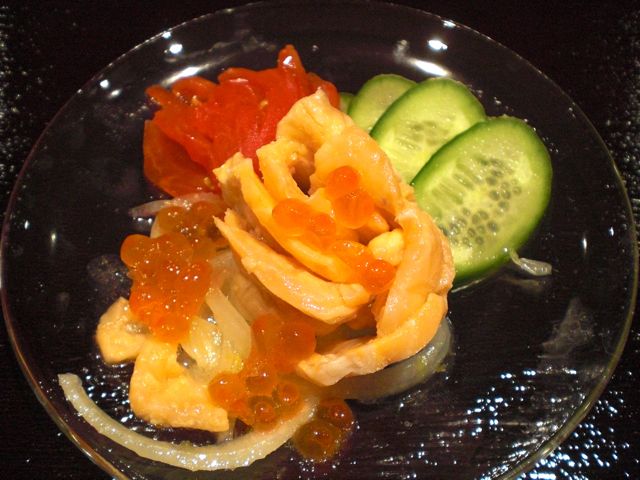
When I made the salmon dish described above, I removed the skin with a bit of the meat attached. Using the skin, I made salmon skin rolls as a "shime" dish. This is a very popular hand roll item in the U.S. but I do not know if any sushi bars in Japan serve this. We like it very much. It is very simple to make, I cooked the salmon skin seasoned with salt, in a frying pan instead of a toaster oven (which is how most sushi bars in the U.S. cook the salmon skin). The skin should be nicely crunchy. I cut the cooked crispy skin into long strips. I used a half sheet of nori crisped up by passing over the gas flame. I smeared real wasabi, added sushi rice, perilla leaf, julienned cucumber and several strips of the salmon skin and made it into a cone shaped hand roll as seen below.
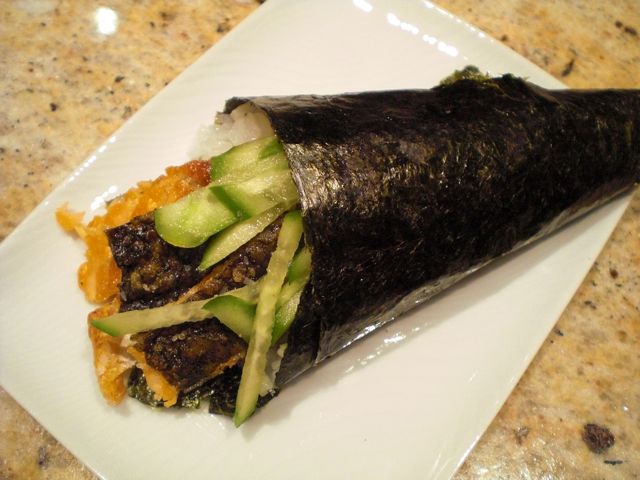
This is a very nice end to your new year's day Izakaya feast.
* I googled (google.co.jp) "鮭のロシア漬け" the marinated salmon recipe and found this blog (in Japanese). The recipe is a very similar to my mother's. According to this blogger, her mother got the recipe from a Japanese magazine "Kurashi no techo" 暮らしの手帖. The recipe is reportedly published in the section called "Apron memo" quite a number of years ago, although the exact year is unclear. Even though the blogger mentioned the recipe was published some time ago, I was eating this as a kid and it is possible my mother's recipe predates even that publication.
* I googled (google.co.jp) "鮭のロシア漬け" the marinated salmon recipe and found this blog (in Japanese). The recipe is a very similar to my mother's. According to this blogger, her mother got the recipe from a Japanese magazine "Kurashi no techo" 暮らしの手帖. The recipe is reportedly published in the section called "Apron memo" quite a number of years ago, although the exact year is unclear. Even though the blogger mentioned the recipe was published some time ago, I was eating this as a kid and it is possible my mother's recipe predates even that publication.
Saturday, January 1, 2011
Happy New Year 2011 明けましてお目出度う御座いました 2011
Saying the New Year's greeting in the past tense must be Hokkadio dialect. My father used to say it this way and my wife somehow picked this up as the correct way to say Happy New Year. Most people, however, will say the greeting in the present tense "明けましてお目出度う御座います".
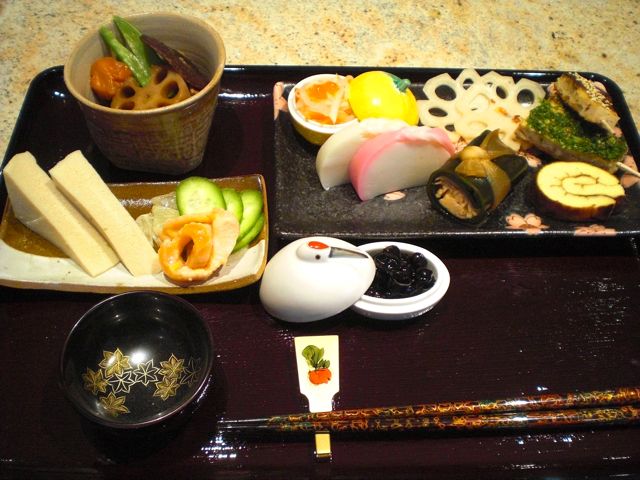
It seems I have made excuses concerning the New Year feast for 2 years running. Last year, I said I had to work until December 31 and could not make the New Year Boxes or "Juubako" 重箱. This time, I have two major excuses both of which led to a paucity of food products; First one of our favorite Japanese grocery stores closed unexpectedly this year and second because of the recent package bomb scare, my mother's annual New Year's "care package" exceeded the new restrictions to be sent by air--it had to be sent by sea and even though it was sent over a month ago it did not arrive in time. In addtion, we are remodeling our house and the Japanese tea room we usually use to celebrate is not available. In any case, I essentially made everthing in one day on December 31. Although I had to "punt" and use frozen premade vegetables for "Umani" New Year stew (left upper) and used a boiled packaged lotus root "renkon" 蓮根 for sweet vinegared renkon 酢蓮根, the rest is homemade (except the fish cakes and black beans).

Here is our new year soup or "ozouni" お雑煮. We used a hybrid broth of vegetable chicken broth my wife made and kelp and bonito stock.
In any case, we started the new year with a good new year breakfast. Happy New Year!
In any case, we started the new year with a good new year breakfast. Happy New Year!
Subscribe to:
Posts (Atom)
